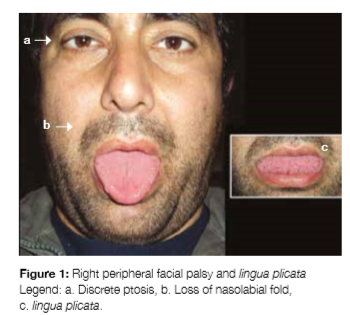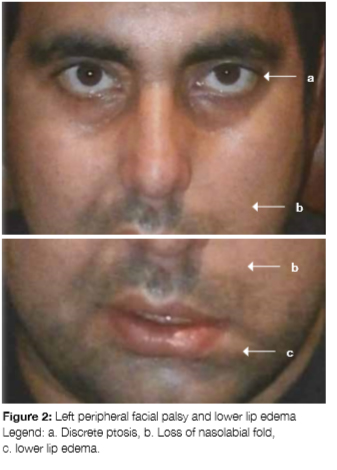Services on Demand
Journal
Article
Indicators
-
 Cited by SciELO
Cited by SciELO -
 Access statistics
Access statistics
Related links
-
 Similars in
SciELO
Similars in
SciELO
Share
Medicina Interna
Print version ISSN 0872-671X
Medicina Interna vol.24 no.4 Lisboa Dec. 2017
https://doi.org/10.24950/rspmi/Im101/17/2017
IMAGENS EM MEDICINA / IMAGENS EM MEDICINA
Melkersson Rosenthal Syndrome
Síndrome Melkersson Rosenthal
Carolina Sepúlveda1, Marta de Sousa1, Isabel Ambrósio2
1Serviço de Medicina Interna, Centro Hospitalar Médio Tejo, Tomar, Portugal
2Serviço de Neurologia, Centro Hospitalar Médio Tejo, Tomar, Portugal
Keywords: Facial Paralysis; Melkersson-Rosenthal Syndrome; Tongue, Fissured.
Palavras-chave: Língua Fissurada; Paralisia Facial; Síndrome Melkersson-Rosenthal.
A 36-years-old male, with personal history of laminectomy for lumbar hernias, presented with sudden facial asymmetry without other symptoms. At examination he had a discrete right peripheral facial palsy and a geographic tongue (Fig. 1). He was discharged with the diagnosis of Bell´s palsy and treated with acyclovir, oral corticosteroids and omeprazol, plus artificial tears and mechanical facial rehabilitation with good outcome.

Three months later, he presented with left peripheral facial palsy associated with lower lip edema (Fig. 2). As before, he denied any other symptoms and, apart from a non-itching and non-painful labial edema and left peripheral facial palsy, he had no other changes on physical examination. He was admitted for etiologic investigation. Blood analysis, thoracic X-ray, cranial computerized tomography and magnetic resonance imaging scans were all normal. Viral serologies were negative. Lumbar puncture was impossible to perform due to previous lumbar surgery. Facial electromyography showed bilateral polyneuropathy of the facial nerve, more significant on the left side. He was discharged with the definitive diagnosis of Melkersson Rosenthal syndrome (MRS). He complied symptomatic treatment with clinical remission and no other relapses until now.

MRS is a rare benign entity of unknown etiology, more prevalent in young adults and is probably paternal inheritance dominated.1 It is characterized by the presence of a classical triad of symptoms such as: a) persistent or recurrent facial edema more frequently on the lips or eyelids, b) relapsing peripheral facial palsy: indistinct from Bells palsy, that can be bilateral (concurrent or asynchronous), c) lingua plicata: geographic/fissured tongue.1-3 If the triad is complete (8% - 25% of the cases), the diagnosis is purely clinic.1,4 If not, a skin biopsy of the edema is required, showing non-necrotizing granuloma, throughout the dermis.4,5 Differential diagnosis includes: stroke, Guillain-Barré syndrome, infections, granulomatous diseases, among others.3,6 Symptomatic treatment can be beneficial.1
Referências
1. Feng S, Yin J, Li J, Song Z, Zhao G. Melkersson-Rosenthal syndrome: a retrospective study of 44 patients. Acta Otolaryngol. 2014;134:977-81. [ Links ]
2. Alves P, von Doellinger O, Quintela ML, Fonte A, Coelho R. Melkersson-Rosenthal syndrome: a case report with a psychosomatic perspective. Adv Mind Body Med. 2017;31:14-7. [ Links ]
3. Gaudin RA, Jowett N, Banks CA, Knox CJ, Hadlock TA. Bilateral facial paralysis: a 13-year experience. Plast Reconstr Surg. 2016;138:879-87. [ Links ]
4. Marques C, Machado A, Baptista AP. Macroqueilites e sindrome de Melkersson-Rosenthal. Revisao de 19 casos. Acta Med Port. 1994;7:53340. [ Links ]
5. Wick MR. Granulomatous & histiocytic dermatitides. Semin Diagn Pathol. 2017;34:301-11. [ Links ] 6. Ricardo Grazina FM, Rita Azenha Cardoso, João Mendes de Abreu. Síndrome Melkersson-Rosenthal - Caso clínico. Rev Port Estomatol Med Dent Cir Maxilofac. 2013;54(S1):e53. [ Links ]
Correspondência:Carolina Sepúlveda sc.carolina@gmail.co
Serviço de Medicina Interna, Centro Hospitalar Médio Tejo, Tomar, Portugal
Av. Maria de Lourdes de Mello Castro - Ap. 118 - 2304-909 Tomar
Direito à Privacidade e Consentimento Informado: Os autores declaram que nenhum dado que permita a identificação do doente aparece neste artigo.
Conflitos de Interesse: Os autores declaram a inexistência de conflitos de interesse na realização do presente trabalho
Consentimento Informado: Os autores declaram que obtiveram o consentimento do doente para publicação dos dados e fotografias
Recebido: 28/06/2017
Aceite: 30/08/2017














